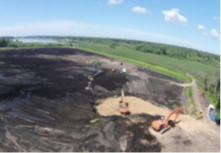The U.S. EPA, together with the Michigan Department of the Environment, Great Lakes, and Energy (EGLE) Water Resources Division, announced the removal of the Loss of Fish and Wildlife Habitat and Degradation of Fish and Wildlife Populations Beneficial Use Impairments (BUIs) at the Muskegon Lake Area of Concern (AOC). These BUIs were removed on May 16th, 2023. BUIs are designations listed in the 1987 amendment to the Great Lakes Water Quality Agreement that represent different types of significant environmental degradation (see Beneficial Use Impairments for the Great Lakes AOCs to learn more). The GLRI provided significant funding for the habitat restoration work required to remove these BUIs. To reach this milestone, all numeric restoration targets established in the strategy developed by EGLE and Muskegon Lake Watershed Partnership were exceeded.
Historically, industrial activity within the Muskegon Lake AOC resulted in shoreline hardening and filling and wetland loss. As a result of this loss of critical habitat, local fish and wildlife populations suffered and declined. To address these BUIs, EGLE and members of the Muskegon Lake Watershed Partnership (MLWP) developed a removal strategy that established quantifiable habitat restoration targets, restoration sites, and plans for restoration. Habitat restoration targets required the removal of a minimum amount of hardened shoreline and unnatural fill and the restoration of a minimum acreage of emergent/upland wetlands and open water wetlands.
To achieve these targets, EGLE and MLWP selected 18 sites for habitat restoration. Completed restoration activities by project partners varied widely and included restoring upland and riparian habitat by removing invasive plants and establishing native species, removing mill debris to restore shallow lake habitat, and dredging and hydrologic reconnection of a lake and stream that were previously separated for agriculture. Project partners restored over 84 acres of emergent wetland and over 51 acres of open water wetland, softened over 26,000 linear feet of hardened shoreline, and removed over 125 acres of unnatural fill. These restored areas within Muskegon Lake and its tributaries provide habitat for local fish and wildlife, enabling populations to improve over time.
Your input is vital as we update the Great Lakes action plan. Attend an upcoming public-input session.
Register and attend upcoming public-input sessions on Great Lakes restoration and protection priorities.
-
Next Virtual Session - June 27.
-
Next in person session - July 12, Superior, WI.




